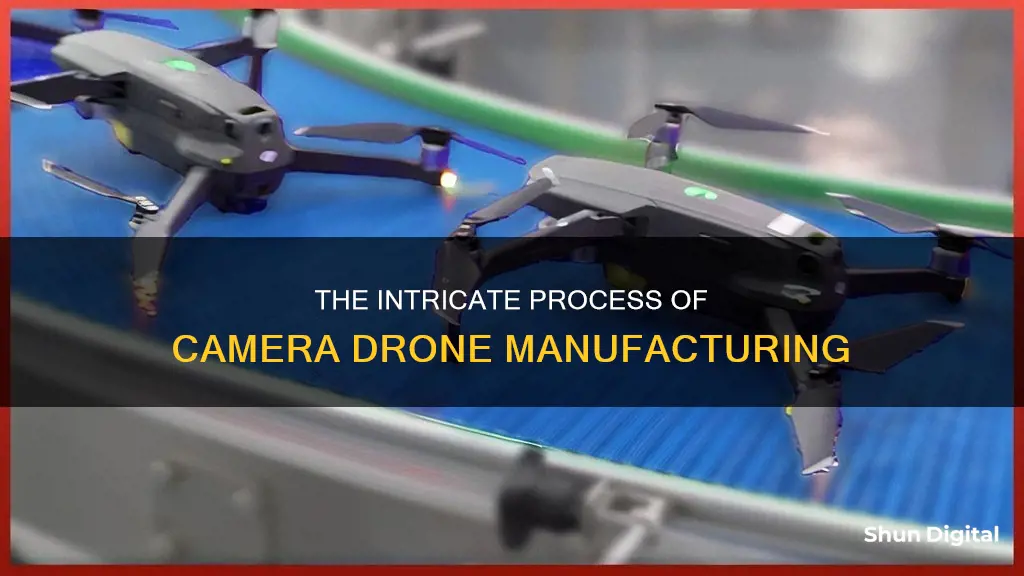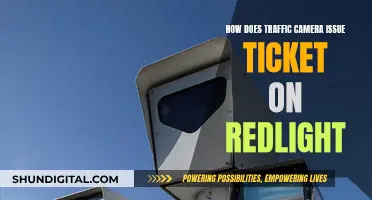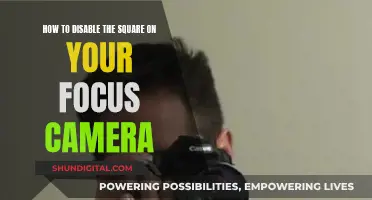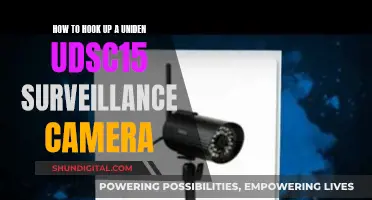
Camera drones are unmanned aerial vehicles (UAVs) that can be remotely controlled for a variety of purposes. They are most commonly associated with military operations and surveillance, but their use in commercial and personal videography is increasing. Camera drones are made using a combination of light composite materials, gimbal and camera technology, infrared cameras, GPS, laser, circuit boards, chipsets and software.
| Characteristics | Values |
|---|---|
| Purpose | Military operations, surveillance, aerial photography, videography, filmmaking, real estate content, travel vlogs, etc. |
| Control | Remotely controlled, pre-programmed to fly specific flight paths by integrating software and GPS information, or hand manipulation |
| Camera | High-quality, lightweight, 4K, 6K, 8K, 1080p, 10-bit colour sampling, 4K resolution, Raw photography, etc. |
| Gimbal | 3-axis, 2-axis, 1-axis |
| Weight | 249g, 250g, 500g, 1kg, etc. |
| Battery Life | 20 minutes, 28 minutes, 30 minutes, 34 minutes, 38 minutes, 40 minutes, 43 minutes, 45 minutes, 46 minutes, 51 minutes, etc. |
| Obstacle Avoidance | Yes, No |
| Range | 7.4 miles, 11 miles, 12 miles, 17.3 miles, etc. |
| Speed | 21 metres per second, 27 metres per second, 30mph, 60mph, etc. |
What You'll Learn

Camera quality and capabilities
The best camera drones offer high-quality video and image capture, with resolutions of at least 12-megapixels for photos and smooth 4K video recording. Some advanced models can even capture 5K or 8K video.
For professional use, larger image sensors and the ability to record using cinema-grade codecs like ProRes are desirable. These can be harder for most people to work with, but they offer greater flexibility in post-processing.
Gimbal stabilisation is another essential feature, as it keeps the camera steady and reduces vibration, resulting in smoother footage and sharper images. Some drones also offer adjustable aperture settings, giving you more control over the exposure and depth of field.
In terms of specific models, the DJI Mavic 3 Pro stands out for its triple-camera system, which includes a 24mm wide-angle lens and two telephoto lenses. It's the first consumer drone to feature three cameras, making it an extremely versatile option for aerial photography and filmmaking.
The Autel Evo Lite+ is another impressive drone, boasting a 1-inch sensor with an adjustable aperture, 40-minute flight time, and excellent low-light performance thanks to its large 2.4um pixels.
For those on a budget, the DJI Mini 2 SE is a great option. It may only support 2.7K video recording, but it's extremely affordable and still delivers smooth, stabilised footage.
When choosing a drone, it's important to consider not just the camera specs but also the drone's safety features, flight time, size, and weight, as these will impact where and how you can fly it.
Charging Camera Batteries: Enercell's Quick Guide
You may want to see also

Drone body and materials
The body of a drone is typically made up of a frame or chassis, arms, motors, propellers, and a battery. The frame or chassis is the component that holds all the other parts together and defines the size of the drone. The arms of a drone support the motors, with longer arms offering greater stability and shorter arms allowing for better manoeuvrability. The motors are located at the ends of the arms and are responsible for generating the propulsive force, with each motor having one or two propellers that make up the powertrain. Most drones have a pair of standard propellers that rotate counterclockwise and a pair of reverse propellers for greater stability during flight.
The materials used in drone manufacturing must be lightweight for flight efficiency, strong for durability, and resistant to environmental elements. Drone parts are typically made from lightweight materials such as plastic or carbon fibre to keep the weight of the drone as low as possible. Carbon fibre is commonly used in the drone's structure or frame due to its high strength and light weight. Other materials used include fiberglass, Kevlar, basalt fibre, thermoplastic composites, aluminium, titanium, magnesium alloys, and copper.
The body of the drone usually has the necessary structure to install a camera, which is one of the most important parts for aerial photography or filming. In addition, a gimbal is often placed between the frame and the camera to stabilise the camera during flight and prevent vibrations from the motors from affecting the quality of the captured images.
Exploring the Sync Button in Adobe Camera Raw
You may want to see also

Drone size and weight
The size and weight of a drone are important factors to consider when purchasing one. Drones come in various sizes and weights, and their weight can range from a few grams to over 100 kilograms. The weight of a drone is significant because it determines whether the drone needs to be registered with the Federal Aviation Administration (FAA) and also affects its performance in the air.
Drones can be categorized into four main groups based on their weight: toy drones, consumer drones, enterprise drones, and professional drones.
Toy drones are typically used as toys for flying and practising how to fly a drone. They are designed to be light and easy to carry, weighing between 20 to 60 grams.
Consumer drones are popular among hobbyists for recreational purposes, such as aerial photography and videography. These drones usually weigh between 250 grams to 1,300 grams. The DJI Mavic Mini, weighing 249 grams, is a popular choice as it falls below the FAA's registration requirement.
Enterprise drones are used for commercial purposes and tend to be heavier than consumer drones to handle more heavy-duty tasks. They can weigh anywhere from 6 to 100 kilograms.
Professional drones are designed to carry extra weight and are used in industrial or military environments. These drones have a high payload capacity, ranging from 20 to 220 kilograms.
The weight of a drone affects its overall flying capabilities. Lighter drones are easier to manoeuvre and may have longer flight times due to more efficient batteries. However, they may struggle in strong wind conditions and may not be able to fly as high or fast as heavier drones. On the other hand, heavier drones are built with more powerful motors and larger batteries, making them better equipped to handle challenging weather and carry heavier payloads.
When choosing a drone, it is essential to consider the intended use and the desired features. Heavier drones are often more expensive and are subject to stricter regulations due to safety concerns. Lighter drones are generally more suitable for recreational use, while heavier drones are preferred for commercial or industrial applications.
Understanding Camera's EV Mode: Creative Control Explained
You may want to see also

Battery life and charging
The battery is the heart of a drone, providing the power needed for the engines to take off. The performance of the battery will significantly affect the overall flight time, speed, and stability of the drone. Most drone batteries are high-rate lithium batteries, which have high energy density, are lightweight, and have high current resistance.
The battery life of a drone varies depending on the type of drone. Lower-quality drones have a battery life ranging from 5 to 10 minutes, while mid-range drones can fly for 15 to 20 minutes. High-quality drones typically have a flight time of about 20 minutes, and professional drones can fly for 20 to 30 minutes. The DJI Mavic 3 Pro is an example of a drone with extended battery life, offering a flight time of up to 43 minutes. Additionally, the DJI Air 3 has a battery life of up to 46 minutes, while the Autel Robotics Evo Lite+ provides a flight time of up to 40 minutes.
There are several factors that influence the flight time of a drone. Firstly, the size and capacity of the battery play a crucial role. Larger batteries with higher milliamp ratings will enable longer flight times. Secondly, the weight of the drone and any additional add-ons will impact battery life. Heavier drones and those with extra gadgets such as cameras or sensors will consume more power, leading to reduced flight time. Thirdly, the number of motors and the surface area of the drone affect battery life. More motors and a larger surface area require more power to keep the drone airborne.
To prolong the battery life of a drone, it is recommended to upgrade to a battery with higher capacity. Additionally, maintaining optimal flying conditions is crucial. Flying in cold weather can reduce battery efficiency, while excessively hot weather increases load on the motors, draining the battery more quickly. Windy conditions also impact battery life, as the drone has to work harder to stay airborne.
It is advisable to have extra batteries on hand to extend the overall flight time. However, this option may come with additional costs and the hassle of maintaining and charging multiple batteries. Another way to improve battery life is to reduce unnecessary weight by removing add-ons that are not required for a particular flight.
When it comes to charging drone batteries, there are several best practices to follow. Firstly, it is important to maintain the battery temperature between 5 and 45°C during charging to avoid damaging the battery capacity. Secondly, the upper limit voltage of charging should not exceed 4.22V. Thirdly, it is recommended to use the batteries within 48 hours of charging or discharge them to the storage voltage of 3.8V-3.9V if not in use. Additionally, it is advised to avoid charging the battery immediately after a flight, as the batteries may still be hot, which can damage the cells. Allowing the batteries to cool down to room temperature before charging is recommended. Lastly, always use the manufacturer's recommended charging station to ensure compatibility and safety.
Camera Battery Explosions: How Common Are They?
You may want to see also

Drone control and software
Camera drones are unmanned aerial vehicles (UAVs) that are remotely controlled by an operator on the ground. They are used for a variety of purposes, from aerial photography and cinematography to industrial applications such as inspections and mapping. The drone control system is a critical component that allows operators to pilot the drone and perform various functions. Here is an overview of drone control and software:
Drone Control Systems:
Drone control systems, also known as ground control stations (GCS), are the interface between the operator and the drone. They consist of a remote controller and a ground cockpit, enabling the operator to fly the drone and monitor its various functions. The controller typically has two joysticks for manoeuvring the drone, along with buttons for specific actions, and a screen to display live footage from the drone's camera.
Autonomous Flight Modes:
Modern camera drones often come with autonomous flight modes that allow them to perform complex tasks without direct operator input. These modes include return-to-home functionality, where the drone automatically returns to its launch point, and follow-me modes, where the drone tracks a subject and captures footage hands-free. Other intelligent flight modes include circular trajectories, sweeping vistas, and cinematic selfie shots.
Collision Avoidance:
Advanced camera drones are equipped with collision avoidance systems that use obstacle detection sensors and software algorithms to create 3D maps of their surroundings. These systems enable drones to sense and avoid obstacles, ensuring safer flights and reducing the risk of crashes. Some drones, like the DJI Mavic 2, have omnidirectional obstacle sensing, allowing them to avoid obstacles approaching from any direction.
Drone Software:
Drone software is a critical component that enables various functions and features. Open-source autopilot software like PX4 and ArduPilot are widely used in the drone industry. These software suites provide advanced capabilities, including real-time communication with operators, autonomous mission planning, and data logging. Additionally, drone software may include ground station software that allows users to set up, configure, test, and tune their drones.
Drone Shows:
Drone shows are a unique application of drone technology, where multiple drones are programmed to create mesmerizing light displays. Drone show software, such as that offered by SPH Engineering, enables users to create complex animations and synchronize the movements of a swarm of drones. This software is used by professionals to design and execute drone light shows for entertainment and celebrations.
Charging the JVC Everio: A Step-by-Step Guide
You may want to see also
Frequently asked questions
A drone is an unmanned aerial vehicle (UAV) that can be remotely controlled and used for various purposes, including military operations, surveillance, and commercial or personal videography.
A typical drone consists of a frame, propellers, a camera, a battery, a flight controller, and a transmitter/receiver for communication.
Drones are typically made of lightweight composite materials, such as carbon fiber or plastic, to reduce weight and increase maneuverability.
Camera drones use a combination of sensors, GPS, and image processing algorithms to navigate and capture images or videos. The camera is usually mounted on a gimbal to stabilize the footage and capture smooth movements.







